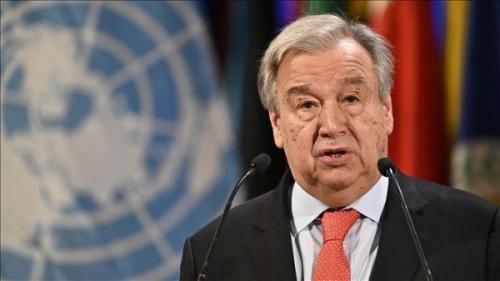The Fury of the Virus, the Folly of War
- Opinión

“Our world faces a common enemy: COVID-19,” United Nations Secretary General António Guterres said on March 23rd. “The virus does not care about nationality or ethnicity, faction or faith. It attacks all, relentlessly. Meanwhile, armed conflict rages on around the world…The fury of the virus illustrates the folly of war. That is why today, I am calling for an immediate global ceasefire in all corners of the world. It is time to put armed conflict on lockdown and focus together on the true fight of our lives.”
Guterres’ ceasefire plea has yielded some positive results. By April 3rd, he reported ceasefires in Cameroon, Central African Republic, Colombia, Libya, Burma/Myanmar, Philippines, South Sudan, Sudan, Syria, Ukraine and Yemen. Actual ceasefires are hard to document, as the so-called fog of war clouds attempts to wage peace. “To silence the guns,” he added, “we must raise the voices for peace.”
Guterres makes a vital point: the novel coronavirus is a common enemy, capable, as we have painfully learned, of killing huge numbers, regardless of the flag one flies. As the outbreak aboard the aircraft carrier USS Theodore Roosevelt demonstrated, even staying aboard a $5 billion nuclear naval vessel offers no protection. And COVID-19’s extreme contagiousness will certainly be on the mind of close to 1,000 West Point cadets, the newest of the U.S. Army’s elite officer corps. They vacated their historic campus in March, when the Army declared a public health emergency. They are now being forced back to campus in June, after President Donald Trump abruptly announced that he would be delivering the commencement address at their previously-cancelled graduation ceremony.
António Guterres noted in his ceasefire plea, “The most vulnerable — women and children, people with disabilities, the marginalized and the displaced — pay the highest price.”
Refugees from conflicts across the world are often held in camps that are crowded and lack proper sanitation — a breeding ground for COVID-19. At a sprawling refugee camp on the island of Chios, in Greece, long described as a “hellhole,” occupants recently protested the death of an Iraqi woman there, after she suffered a fever. Camp residents believed the death was due to COVID-19, and that she suffered, as they all do there, from dismal medical treatment. On either side of the U.S/Mexico border, asylum seekers face the threat of infection, either in squalid camps that have sprung up in Mexican border cities as a result of the Trump administration’s “remain in Mexico” policy, or in immigration jails like the Otay Mesa Detention Center in San Diego — a private prison run by CoreCivic — where prisoners have been pepper sprayed and attacked by guards for demanding access to protective face masks.
Palestinian refugee camps in Gaza and Lebanon also suffer heightened risks of COVID-19 infection, exacerbated by many decades of systemic impoverishment, poor sanitation, and the denial of access to medical care.
COVID-19 has prompted a look back at previous pandemics, including the 1918 flu that swept the planet, killing an estimated 50-100 million people. It may even have hastened the end World War I, wiping out thousands of soldiers on both sides. The illness has long been called “The Spanish Flu,” a misnomer, as it almost certainly did not originate in Spain. News was censored in the warring countries of France, Britain and Germany, but not in Spain, which became the key source of European pandemic news, hence the name. An outbreak in Kansas led to infection of thousands of U.S. soldiers bound for the war in Europe, which added to the deadly flu’s global spread.
Much earlier in WWI, long before the scourge of the flu, a remarkable, albeit short-lived, ceasefire occurred. On Christmas Eve 1914, along the Western Front, German soldiers sang carols from their trenches, and soon British and French troops followed suit. By daybreak, an informal ceasefire had taken hold. Soldiers left their trenches, embracing their enemies in No Man’s Land, playing pickup soccer games and sharing champagne and cigarettes.
That pandemic, that war, and the “Christmas Truce” are distant memories now. Have we learned anything? How we confront the coronavirus as a global community will tell. UN Secretary General António Guterres concluded his ceasefire call last March 23rd, when the number of confirmed cases globally was “only” 300,000 — it has since grown to over 3 million: “End the sickness of war and fight the disease that is ravaging our world. It starts by stopping the fighting everywhere. Now.”
The original content of this program is licensed under a Creative Commons Attribution-Noncommercial-No Derivative Works 3.0 United States License. Please attribute legal copies of this work to democracynow.org.
Del mismo autor
- Putin’s war on Ukraine could spark a nuclear catastrophe 04/03/2022
- La persecución de Biden contra Julian Assange 18/01/2022
- Biden’s persecution of Julian Assange 06/01/2022
- ¿Reconstruir mejor o construir más bombas? La elección es clara 13/12/2021
- Facebook Papers: cumplicidade no ódio, nas mentiras e na violência 28/10/2021
- Es hora de eliminar a Facebook de nuestra lista de amigos 11/10/2021
- El espía que se metió en tu teléfono 20/09/2021
- De Kabul al río Bravo, Estados Unidos crea crisis de refugiados 31/08/2021
- Después de décadas de guerra, el pueblo afgano merece la paz 23/08/2021
- Código rojo: la emergencia climática exige una acción inmediata 16/08/2021
Clasificado en
Clasificado en:
Guerra y Paz
- Prabir Purkayastha 08/04/2022
- Prabir Purkayastha 08/04/2022
- Adolfo Pérez Esquivel 06/04/2022
- Adolfo Pérez Esquivel 05/04/2022
- Vijay Prashad 04/04/2022
Pandemia
- Gabriela Ramírez Mendoza 07/02/2022
- Jyotsna Singh 06/02/2022
- Gabriela Ramírez Mendoza 06/02/2022
- Richa Chintan 10/01/2022
- Isaac Enríquez Pérez 03/01/2022








